#dwarf cichlid
Explore tagged Tumblr posts
Text

the hues of freshwater fish
I've posted these separately a long time ago, but I've never put them here as a set! They were all painted traditionally in gouache - I've got these available as magnets, charms or stickers in my shop! :)
I'm planning some new ones for December~
3K notes
·
View notes
Text
love it when someone's nickname for their pet becomes a totally fucking incomprehensible bunch of syllables that has nothing to do with their original name
this post was brought to you by calling my fish Goemon "Blooberino"
#subbyp's fishious little tank#apistogramma borellii#yellow dwarf cichlid#umbrella cichlid#fishblr#it went Goemon-->Mr. Blue Butt--> Blueb-->Blooby bloo-->Blooberino#in a similar vein we have Hal-->Nugget Man-->Nugs-->the Dankest Nugs
5 notes
·
View notes
Text
One of the cool things about human brains is that we can practice our responses to things we've never actually experienced.
Children love to play imagination games including dark and dangerous situations because it's how their brains work out a script of what to do if that ever actually happens. Adults like to read and watch and create media about horrible things, things they've never experienced (and hope never to experience) because it lets them play out and consider how they would act in that situation, laying down neural pathways for it ahead of time.
I think people who say "if you write about X happening, or like fiction where X happens, you like X" have it completely backwards tbh. People often like writing/reading/watching things about X happening not because they want it to, but precisely because they don't. Engaging with it in fiction lets their brains go "good job! you're prepared now!".
Every single time I see a take that amounts to "if you write about X happening, or like fiction where X happens, you like X" I'm reminded of this one time I was at a casual friends house as a young kid. We were in her room, pretending to "be orphans" escaping from an evil orphanage and having to take care of each other and fend for ourselves. It was all very Little Orphan Annie/All Dogs Go to Heaven and based on the 80s pop media.
And this girl's mom comes in, hears what we're playing and gets all MAD and UPSET. She says that if we play act something, it's because we want it to happen. So her daughter must WANT HER TO DIE.
First off lady, we were 6 year year olds, so take it down several notches. We barely had a concept of mortality for fucks sake. She made us feel so guilty and ashamed, because she was taking our game personally.
Now I have a 5 year old. And sometimes she looks at me and says "pretend you're dead, and I have to -" Whatever it is. Some adult task she's assigned herself.
And it's just so transparently obvious that she's practicing the idea of having to do things on her own. Which is exactly what 5 year olds are supposed to do. I actually find it very flattering that the only way she can envision me not being available to help her is to be literally deceased. Otherwise, obviously, she wouldn't have to do scary hard things alone.
It's a natural coping mechanism. She's self-soothing about what would happen if I wasn't there by play-acting independence in a perfectly safe environment. She's also practicing skills she needs, and making up excuses for practicing them on her own, without taking on the responsibility of being able to do them by herself all the time yet.
Humans mentally rehearse bad this in their brains all the time. We can do that by ruminating- going over worries over and over again, which tends to lead to anxiety and helplessness and depression. Or we can do it with a sense of play- by recognizing that the fiction is fiction and we can dip our toe into these experiences and expose ourselves to bad things without actually being injured.
My daughter does not want me dead. And I don't want bad things to happen in real life. But fiction and pretend help me face the horrors of the world and think about them without collapsing or messing myself up mentally.
#writing#also yeah so vaspider's response reminds me of something I learnt recently about apistogramma dwarf cichlids#they're territorial and form pair bonds but in tanks after a while pairs may turn on each other to the point of straight up killing#and y'know what seems to help prevent this? adding a mirror from time to time#they're built to experience conflict and violence and negative social interactions and if you deny them that they'll find it in each other#give them a mirror now and then and they both get to go absolutely screaming mad at these other fucking fish that they Hate#it's clearly stressful and aggressive and drives them mad but actually it's *good* for them from time to time#kinda reinforces ''this fish is good it is my partner not like those other bastards''#complex brains need some form of external stress sometimes or they'll find stress wherever they can#apistos evolved to live with horrible neighbours they sometimes brawl with it's a sort of calibration I guess?#they will be violent at some point they need an external factor to direct it though#I wonder whether human generalised anxiety might in some cases be a similar thing of like...without real but rare dangers present#the brain goes 'well I gotta be anxious about *something*'#and so you're having a panic attack about going to the shops for some milk#because your life does not contain enough leopards to calibrate your brain's ''when to feel flailing fear'' circuitry
60K notes
·
View notes
Text

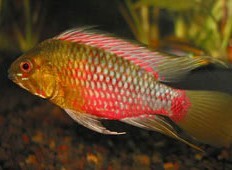
red lined dwarf cichlid
#fishmikey#mcr ecosystem#mcr#mikey way#cichlid saturday#mikey wearing day of the dead shirt..... best george a romero movie....... if u even care.....#i gotta time travel to 2005 to talk to him about those movies
54 notes
·
View notes
Text
🐟 Mercraft: Fish Mode! A (mostly) complete guide ^^
New Order of the Stone: (all are species found in Minecraft)
Jesse- cod
Lukas- dolphin
Petra- sockeye salmon
Axel- sea turtle
Olivia- squid
Reuben- sea pigckle /j clownfish
Dewey- pufferfish

Blaze Rods:
Aiden- jaguar cichlid
Gill- he’s the only human /j snakehead probably
Maya- rainbow smelt
Old Order of the Stone:
Gabriel- North Atlantic swordfish
Ellegaard- Argentine shortfin squid
Magnus- dwarf sawfish
Soren- common cuttlefish
Ivor- blue-ringed octopus
Witherstorm- giant squid or kraken “Ichorstorm”

Portal Arc:
Isa- rainbow darter
Milo- banana eel
Reginald- fantail darter
Benedict- oyster “Eversoyster”
Harper- East Pacific red octopus
PAMA- arapaima “AraPAMA”
Hadrian- shovelnose sturgeon
Otto- brook trout
Mevia- vampire squid
Cassie- brindled madtom
Nell- mahi-mahi
Em- bull shark
“Tim”- great white

Champion City:
Radar- logperch
Stella- emperor angelfish
Lluna- narwhal
Sea Temple:
Jack- lemon shark
Vos- oarfish
Sammy- flying fish
Nurm- mirror carp
Prismarine Colossus- coelacanth
Elder Guardians- sacabambapsis

Sunshine Institute + Underneath:
Warden- lamprey
Oxblood- goliath tigerfish
Carmine- goblin shark
Binta- whale shark

Admins:
Romeo- lionfish (+crab armor)
Fred- blue jellyfish (+clam armor)
Xara- pelagic stingray (+starfish armor)
“Vos”- anglerfish
Snowmeo- crocodile icefish

I know there are characters I missed; if you want to ask about someone, please do! I’d be happy to assign them a fish! Also if you want to know the reasoning behind any of these choices, I’m happy to answer! I will discuss fish choices ALL DAY. (Ex. Most engineers or scientists were assigned species of octopus/squid because having more arms is useful.) :]
The Mercraft: Fish Mode tag just started out as the MC:SM equivalent of Mermay for me but y’all are free to use it even if you have differing fish ideas for the characters! Bonus: Aiden and Radar’s concepts can be found here!
#started this yesterday and my poor camera roll is now an ocean#mcsm#minecraft story mode#only tagging the new order because these are just teeny sketches#mcsm jesse#mcsm lukas#mcsm petra#mcsm axel#mcsm olivia#bermuda brainrot hours#scriptscratches#mercraft fish mode
108 notes
·
View notes
Text

Drawn Nov 4 - 11 2024 My part of an idol trio with ARaccoonNamedPeacock and N8-0. The red-haired character is Kira and the blue haired one is Yukio.
I uh. really read peacock's description that read "pop group" and "girls preferred" and went "counterpoint! goth enby," huh? okok I'm joking-- they weren't requirements, and I did consider both people's designs and the rest of the description when doing my own and doing research.
So this character doesn't have a name, I haven't actually picked a gender either, but they're a panda dwarf cichlid - since I decided to go for a yellow character to fit with the others and that fish is yellow but also sometimes has red and blue which fit with the other colours.
It's not super obvious with the outfit but I did try to give this character scoliosis and the darker brown on their cheeks is melasma.
There's obviously alt influences in this character, but I was also looking at Ouji Kei specifically. I used this person's wardrobe for a lot of the reference
The colours of the top left one were my second pass I think? the first I don't have anymore but it doesn't matter they were very obviously not meant to be a final
The ones on the middle and top right are my third which I just edited today. brought some more focus on the yellow and attempted to bring the colours from the other characters into it but eh. The red is from Kira but all of Yukio's blues were too bright
The top right I simplified the design a tiny bit, since I wanted to do "maybe a little overdesigned" with mine: but also for ease of drawing and the fact that they're with two other characters they need a simpler version
I also was attempting peacock's style with that one because when designing this one I wanted it to still be different from my other characters and be interesting for myself, but also make sure that it kinda fit her style without changing too much? N8-0 will have to figure it out himself if he wants to draw them though, sorry lol
The bottom one I drew the three together for one last seeing if they fit together and making adjustments to my colours, as well as simplifying the design further/differently
I do like the extra colours but I felt like mine stood out a lot and in the middle of figuring out how simplified I wanted it I realized that the fact that this one's "the yellow one" wasn't as clear so I ended up just making them mostly yellow. It's fine anyway, Kira was the first character here so she can look more of a main character. I kept that little bit of red from kira though and ended up being able to take one of Yukio's blues for the eye there
I might change the skintone back to being a little redder and differentiate the yellows more again though, I think that's a little weird but I don't wanna look at this anymore. They've got multiple options now
#splatoon fish#splatoon idol#splatoon#splatoon art#splatoon fanart#nintendo#art#artwork#my art#artists on tumblr#sketch#digital sketch#sketchpage#concept art#Drawing#my drawing#digital drawing#fanart#original character#original characters#oc#ocs#my oc#kira#yukio#antón#toni
21 notes
·
View notes
Text
the list!!!
every creature that's endangered or critically endangered or extinct in the wild that you can keep and breed in your own (freshwater) aquarium to stop it from dying out completely.
ive been working on this for a while and its still very not done bc oh my god theres so many-
some of these are super duper rare and expensive but others are widely beloved fish, some of them are rlly surprising to see here
pls lmk if theres anything i should add that i havent yet :3 theres a lot of undescribed species that you dont find in databases and stuff so i need all the obsessed nerds i can find to finish this!!!
not bolded = endangered
bolded = critically endangered
red = extinct in the wild (THESE LITERALLY ONLY EXIST WHERE WE KEEP THEM 0.0)
okay here it is :3
Allodontichthys polylepis - Finescale splitfin
Allotoca catarinae - Catarina allotoca
Allotoca dugesii - Bumblebee goodeid, Opal allotoca
Allotoca goslinei - Banded allotoca
Allotoca maculata - Blackspot goodeid, Blackspot allotoca
Allotoca meeki - Zirahuen allotoca
Allotoca zacapuensis - Zacapu allotoca
Amatitlania kanna - Panama convict cichlid
Amatitlania myrnae - Topaz cichlid
Ambystoma mexicanum - Axolotl
Ameca splendens - Butterfly goodeid
Amphilophus chancho
Amphilophus flaveolus
Amphilophus lyonsi
Amphilophus zaliosus - Arrow cichlid
Apistogramma lineata
Apistogramma psammophila - two banded dwarf cichlid
Aponogeton capuronii
Aponogeton longiplumulosus
Astatotilapia desfontainii
Ataeniobius toweri - Striped goodeid
Aulonocara baenschi - Nkhomo-benga peacock, yellow benga, sunshine peacock
Aulonocara kandeense - Blue orchid peacock
Aulonocara maylandi - Sulfurhead peacock
Bedotia geayi - Madagascar rainbowfish, red-tailed silverside, zona
Bedotia madagascariensis - Madagascar rainbow, Madagascan rainbowfish
Benitochromis conjunctus
Benitochromis finleyi
Benitochromis nigrodorsalis
Benitochromis riomuniensis
Betta albimarginata - Whiteseam fighter
Betta antoni
Betta sp. “api api” - Api api betta
Betta burdigala
Betta channoides - Snakehead betta
Betta chloropharynx - Green throat mouthbrooder
Betta compuncta
Betta cracens
Betta foerschi
Betta hendra
Betta hipposideros
Betta sp. “jade” - Jade betta
Betta livida
Betta mahachaiensis - Mahachai betta
Betta mandor
Betta miniopinna
Betta omega
Betta pardalotos
Betta patoti - Tiger betta
Betta persephone
Betta pi
Betta rubra - Toba betta
Betta rutilans - Fire betta
Betta schalleri
Betta simplex - Krabi mouthbrooding betta
Betta smaragdina “guitar”
Betta spilotogena
Betta stiktos
Betta tussyae - Chukai betta
Betta waseri
Brevibora dorsiocellata - Emerald eye rasbora, eyespot rasbora
Cambarellus patzcuarensis - Mexican dwarf crayfish
Caridina dennerli - Cardinal Sulawesi shrimp
Caridina glaubrechti - Red orchid Sulawesi shrimp, red orchid shrimp
Caridina holthuisi - Six banded Sulawesi shrimp
Caridina loehae - Mini blue bee shrimp, orange delight shrimp
Caridina masapi - Towuti tiger shrimp
Caridina profundicola - Sunstripe shrimp
Caridina spinata - Yellow goldflake shrimp, yellow nose shrimp, yellow cheek shrimp
Caridina spongicola
Caridina striata - Red line shrimp
Caridina tenuirostris
Caridina tigri - Tigris sulawesi shrimp
Caridina woltereckae - Sulawesi harlequin shrimp
Chapalichthys pardalis - Polkadot splitfin
Characodon audax - Bold characodon
Characodon lateralis - Rainbow goodeid, Rainbow characodon
Chilatherina bleheri - Blehers rainbowfish
Chilatherina sentaniensis - Sentani rainbowfish
Chindongo saulosi
Coelotilapia joka
Coptodon bythobates
Coptodon deckerti
Coptodon gutturosus
Coptodon kottae
Coptodon snyderae
Cyprinodon alvarezi - Potosi pupfish
Crenichthys baileyi - White River springfish
Cribroheros bussingi
Cribroheros rhytisma
Danio/Celestichthys erythromicron - Emerald dwarf rasbora
Devario auropurpureus/Inlecypris auropurpurea - Lake Inle danio
Devario pathirana - Barred danio
Dicrossus gladicauda
Epalzeorhynchos bicolor - Redtail shark/red tailed shark
Etroplus canarensis - Canara pearlspot
Gambusia hurtadoi - Crescent gambusia
Girardinichthys multiradiatus - Dark-edged splitfin
Girardinichthys viviparus - Chapultepec splitfin
Glossolepis dorityi - Doritys rainbowfish, Grime rainbowfish
Glossolepis incisus - Red rainbowfish
Glossolepis maculosus - Spotted rainbowfish
Glossolepis wanamensis - Lake Wanam rainbowfish, emerald rainbowfish, green dragon rainbowfish
Gymnogeophagus caaguazuensis
Halocaridina rubra - ‘Opae‘ula
Haplochromis brownae
Haplochromis ishmaeli
Haplochromis latifasciatus - Zebra obliquidens
Haplochromis perrieri
Hemichromis cerasogaster
Herichthys bartoni - Bartons cichlid
Herichthys labridens - Curve-bar cichlid
Herichthys minckleyi - Minckleys cichlid
Herichthys steindachneri - Steindachners cichlid
Hubbsina turneri - Highland splitfin
Hypancistrus zebra - Zebra pleco
Hyphessobrycon flammeus - Flame tetra
Kiunga ballochi - Glass blue eye
Konia eisentrauti - Konye
Lamprologus kungweensis - Ocellated shell dweller
Limbochromis robertsi
Limia islai - Tiger limia
Limia nigrofasciata - Humpbacked limia, Black-barred limia
Limia sulphurophila - Sulphur limia
Lipochromis/Cleptochromis/Haplochromis parvidens
Luciocephalus aura - Peppermint pikehead
Malpulutta kretseri - Ornate paradisefish
Mchenga conophoros
Melanochromis chipokae
Melanochromis lepidiadaptes
Melanotaenia ajamaruensis - Ajamaru rainbowfish, Ajamaru lakes rainbowfish
Melanotaenia boesemani - Boesemani rainbowfish
Melanotaenia bowmani - Bowmans rainbowfish
Melanotaenia fasinensis
Melanotaenia gracilis - Slender rainbowfish
Melanotaenia klasioensis - Klasio Creek rainbowfish, Klasio rainbowfish
Melanotaenia lacustris - Turquoise rainbowfish, Lake Kutubu rainbowfish
Melanotaenia mairasi - Lake Furnusu rainbowfish
Melanotaenia parva - Lake Kurumoi rainbowfish, sunset dwarf rainbowfish
Melanotaenia sp. “Running River” - Running River rainbowfish
Melanotaenia sembrae
Melanotaenia sexlineata - Fly River rainbowfish
Melanotaenia susii - Susi Creek rainbowfish
Melanotaenia utcheensis - Utchee rainbowfish, Utchee Creek rainbowfish
Melanotaenia sp. “Williams Creek” - Malanda gold rainbowfish, Williams Creek rainbowfish
Mesoheros gephyrus
Metriaclima koningsi
Metriaclima usisyae
Microrasbora rubescens - Red dwarf rasbora
Myaka myaka - Myaka
Nandopsis ramsdeni
Nannostomus mortenthaleri - Coral red pencilfish
Nanochromis transvestitus
Neoophorus regalis
Neotoca bilineata - Twoline skiffia
Nyassachromis boadzulu
Oreochromis alcalicus - Soda cichlid, common natron tilapia
Osphronemus laticlavius - Giant red tail gourami
Parananochromis ornatus
Paretroplus dambabe
Paretroplus maculatus - Damba mipentina
Paretroplus menarambo - Pinstripe damba
Paretroplus nourissati
Parosphromenus alfredi
Parosphromenus anjunganensis
Parosphromenus filamentosus
Parosphromenus gunawani
Parosphromenus harveyi
Parosphromenus linkei
Parosphromenus opallios
Parosphromenus ornaticauda
Parosphromenus pahuensis
Parosphromenus paludicola
Parosphromenus phoenicurus
Parosphromenus quindecim
Parosphromenus rubrimontis
Parosphromenus tweediei
Phallichthys quadripunctatus - Four spotted toothcarp, four spotted merry widow
Placidochromis phenochilus
Poropanchax/Congopanchax myersi - Hummingbird lampeye
Pseudomugil connieae - Popondetta blue eye
Pseudomugil furcatus - Forktail blue eye
Pseudomugil ivantsoffi - Ivantsoffs blue eye
Pseudomugil luminatus - Red neon blue eye
Pseudomugil mellis - Honey blue eye
Pseudotropheus cyaneorhabdos - Maingano cichlid
Ptychochromis insolitus - Mangarahara cichlid
Ptychochromis oligacanthus
Pungu maclareni - Pungu
Priapella olmecae - Olmec priapella
Quintana atrizona - Barred topminnow
Rocio spinosissima
Sahyadria/Dawkinsonia denisonii - Denison barb, red line torpedo barb, roseline shark
Sarotherodon caroli - Fissi
Sarotherodon knauerae
Sarotherodon linnellii - Blackfin tilapia
Sarotherodon lamprechti
Sarotherodon logbergeri - Keppe, keppi
Sarotherodon steinbachi - Kululu
Scleropages formosus - Asian arowana
Sewellia marmorata
Skiffia francesae - Golden skiffia
Skiffia lermae - Olive skiffia
Skiffia multipunctata - Spotted skiffia
Skiffia sp. “Sayula” - Sayula skiffia
Sphaerichthys vaillanti - Samurai gourami, vaillants chocolate gourami
Stomatepia mariae - Nsess
Stomatepia mongo - Mongo
Stomatepia pindu - Pindu
Tanichthys albiventris
Tanichthys albonubes - White cloud mountain minnow, white cloud minnow
Tanichthys micagemmae - Vietnamese cardinal minnow, Vietnamese white cloud
Teleogramma brichardi
Tilapia guinasana - Otjikoto tilapia
Trigonostigma somphongsi
Vieja hartwegi - Tailbar cichlid
Xenoophorus captivus - Relict splitfin
Xenotoca doadrioi - San Marcos redtail splitfin, San Marcos redtail goodeid
Xenotoca eiseni - Redtail splitfin, Redtail goodeid
Xenotoca lyonsi - Tamazula redtail splitfin
Xenotoca melanosoma - Black splitfin
Xenotoca cf. melanosoma
Xiphophorus andersi - Spiketail platyfish
Xiphophorus couchianus - Monterrey platyfish
Xiphophorus meyeri - Marbled swordtail
Zoogoneticus tequila - Tequila splitfin
#aquatic#aquarium#fish#endangered#endangered species#fishkeeping#wild type betta#goodeids#endangered animals#aquatic ecosystems#cichlid#gourami#livebearing fish#fishblr
24 notes
·
View notes
Note
Jonathan, if you could be a fish, what fish would you be?
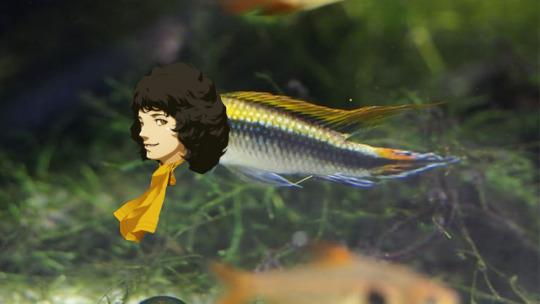
agassiz's dwarf cichlid
20 notes
·
View notes
Text
Freshwater Tropical Fish
Nothing beats having a well-planned and well-maintained freshwater community tank, with a lot of different species that live well together. Some fish need to be alone with their own species, but there is an amazing cross-section of suitable fish for a community tank.
Some of my favorites:

Clown Loaches are big hams, and like to be with at least one other loach in a community tank.

And yes, a single betta in a community tank can work great as long as there aren't fin nippers in the tank.
And everyone knows and loves the tetras: neon, cardinal, and glowlights the three main varieties:
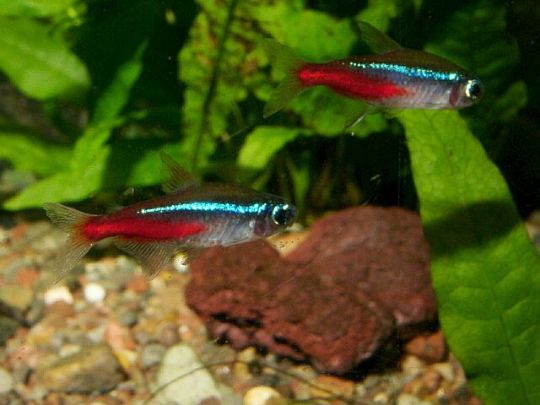



And guppies are easy to raise and can get really fancy.


And my personal favorites, the Pearl Gouramis and Dwarf Gouramis, both excellent if you keep them in pairs or fours. The Pearl Gourami is an easy-to-breed bubble-nester, as is the Dwarf.

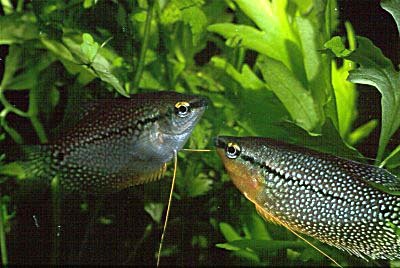

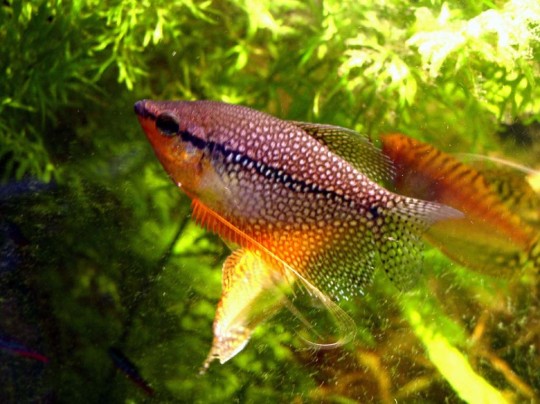




The Dwarf is less streamlined than the Pearl, and much smaller, about half the size of the Pearl Gourami.
Another community fish that should be kept in small schools like the tetras is the White Cloud Mountain Fish or White Cloud Mountain Minnow, a colorful little fish that likes a community tank.
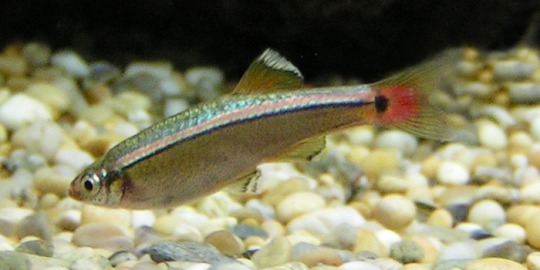
And I have had varying degrees of success with having a single angelfish in a community tank, but a tank full of nothing but angels is truly awesome as well.

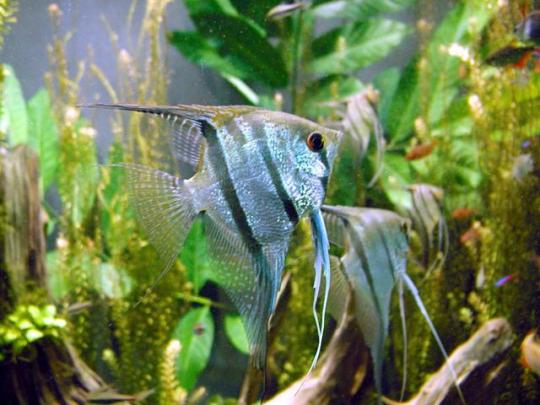
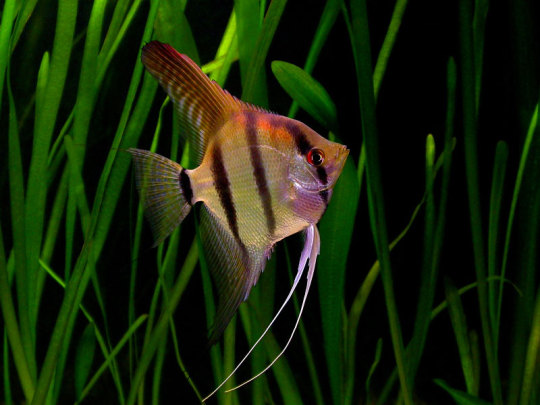

And every community tank needs one of THESE ugly mothers:

A plecostomus will add hours of enjoyment watching it either sit still for days or be suckered onto the glass for awhile. A bottom-feeder and algae-eater is a valuable part of the community.
And in the "does not play well with others" category, we have the rest of the Cichlids, a dizzying array of species that only work well with other cichlids in a "rock tank".

I'd love to have a community tank setup again before I kick off. I can watch fish for hours.
3 notes
·
View notes
Text
Whoops! Trap card activated! Now I'm talkin' bout my fish!
Starting with listing all the named ones, their species, and any special conditions/identifiers especially since quite a few were adopted.
(Please note, they are not all in the same tank.)
Commander Peepers - Copper Koi Betta (missing eye)
Caine - Sarasa Goldfish (feeder fish rescue, scar from prior infection on lower jaw)
Pomni - Comet Goldfish (feeder fish rescue)
Mr. Mystery - Black Moor Goldfish (missing eye)
A-Con - Polar Blue Parrot Cichlid (raised from fry)
Cyrano - Gold Mickey Mouse Platy (raised from fry, and VERY in love with A-Con)
Void, Abyss, and Vanta - Black Molly (surrendered pets)
Winifred, Sara, Mary, Billy, and Thackery - Yo-Yo Botia Loaches
Jack Black - Bristlenose Pleco
Benoit Blanc - Albino Bristlenose Pleco
Dr. Screwball Jones - Clown Pleco
Mike Wazowski - Dwarf Gourami (missing eye)
Bill Cipher - Albino Rainbow Shark (missing eye)
Pugsley - Gloshark (abnormal skull shape)
Pantaloons - Red Tail Shark (surrendered pet)
Pongo - Dalmatian Molly (raised from fry)
Skwisgaar - Blonde Delta Guppy
Bluey and Twoey - unknown Guppy species (raised from fry)
The Gorls (6) - Yellow Guppies (raised from fry)
3 notes
·
View notes
Note
Hello! I’m new to your account and 1) I absolutely love your tank setups, literal planted tank goals. I was wondering what you’re going to stock your 10 gal with as I’m in the process of redoing mine and am looking at options! Rn I’m probably going to end up with a betta in mine and then hopefully start a 20 long for some other nanos in the future, but I feel like it’s hard to find good options for 10 gallons as most people seem to encourage just putting any fish possible in there, so it’s been a bit tricky for me to find what fish will actually do well lol
Hello and welcome!! Thank you so much for the compliment Anon~❤️! It makes me happy to hear that 😊
10 gals can be a bit tricky to stock it's true. Especially since most fish have to be in groups of 6 or more so you have to decide if you want to stock the bottom or the water column.
I was originally going to stock my tank with around 10 or so chili rasboras and a couple amano shrimp. But I found some other fish I have always wanted and went with 7 Daisy's blue rice fish instead. I'm a sucker for blue lol
Some other options for a 10 gal could be 8 or so Celestial Pearl Danios/Galaxy Rasbora, exclamation point rasbora, dwarf emerald rasbora, or green neon tetra. Maybe a couple of sparkling gourami if it's densely planted. A single Honey Gourami would be nice, too!
If you have a lid, you can try out furcata rainbow fish, spotted blue-eye rainbow fish or any pseudomugil species, clown killifish, or marble hatchetfish, and of course, a single betta could work as well.
For algae eaters, you can try cherry shrimp or a couple of Amano shrimp. Be careful about putting them in with bettas or gourami, though, as sometimes they might be predated on.
I know some people don't like them but snails are friends! They're a good indicator if you're overfeeding or not, and they graze on algae. I personally like Ramshorn snails. They come in different colours and can get to the size of a quarter. Be careful about Apple snails, though, in my experience, they eat plants the very moment there isn't some other readily available food in the aquarium.
There's also dwarf cichlids you can try out, but I have yet to dip my toes into that side of the hobby so I don't know too much about them other than the minimum being a 10 gal for certain species.
For a 20 gal you can try a smaller species of Corydoras, like Pandas, Salt and Pepper, Dwarf, Pygmy, Nanus to name a few.
If you want something odd, then maybe a Dwarf anchor catfish, or a school of 6 or so, kuhli loaches.
Also, a must for a planted 20gal and up would be otocinclus. There's a few different types, like the zebra, but they can be a bit pricy and hard to find.
If you wanted to go unheated, then a little school of 8 or so white cloud mountain minnows could work. They also sell an albino variety, usually called the golden white cloud.
That's all I can think of off the top of my head. So I hope that gives you some better ideas stocking wise or leads you to find the perfect fish for your 10 or your future 20long!
3 notes
·
View notes
Text

Next one in the series, cockatoo dwarf cichlid!
You can get a magnet with this and the 4 other fish I just painted if you're on any of my print Patreon tiers :)
873 notes
·
View notes
Text
there is a ghost haunting the city, selling a handful of homebred dwarf cichlids to every major aquarium store, and astute shoppers can follow his trail of breadcrumbs across the city if they want to collect all the A. borellii in the region
5 notes
·
View notes
Text
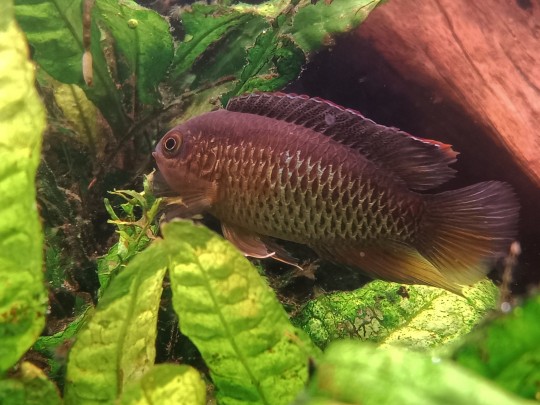
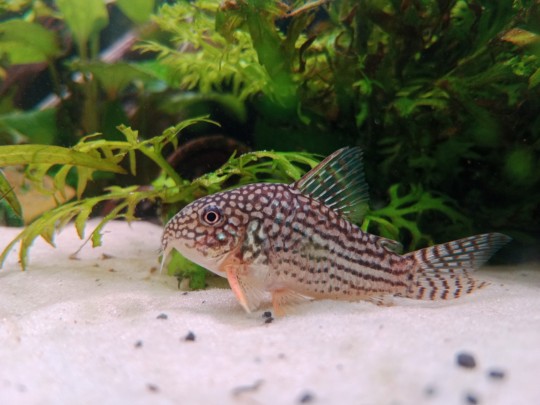
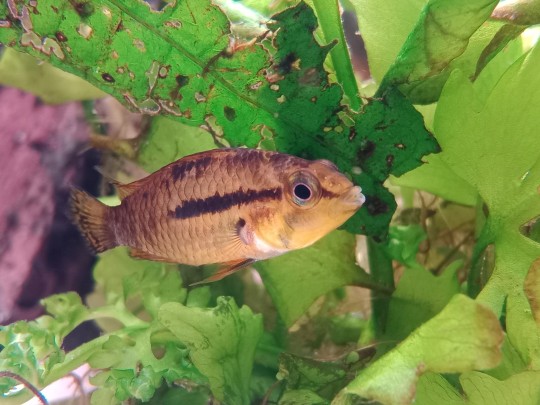
Recent aquarium portraits
Nannacara anomala - Adult male Golden Dwarf Cichlid
Corydoras sterbai
Apistogramma cacatuoides - juvenile female Cockatoo Cichlid
2 notes
·
View notes
Text
As a child, I grew up encouraged yo take an interest in aquariums, and particularly in tropical fishes. But the vibrant tropical marines, I was told - the fishes from the coral reef - were simply too 'hard' or 'impossible', especially for a child. When I first took a serious interest in cichlids from the Great Lakes in East Africa, I was again told that they were unsuitable for me; that they needed 'special' water. Such advice surely daunts many fishkeepers from trying fish from Lakes Malawi or Tanganyika, though many people have local water supplies that are perfectly suited for their needs - as in a hard and alkaline freshwater. As is preferred, incidentally, by the regular platies and the like; their needs in this regard do not stand apart from those of 'normal' tropical fishes, rather, they are at one end of a pH spectrum.
The native animals in the ecosystems of these ancient lakes - including the snails, crabs, and fishes - have evolved in ways that parallel marine fauna from shallow seas, although their ancestors may in fact be quite different, despite appearances - the phenomenon called convergent evolution. Although cichlids actually are a part of the 'perchlike' radiation, together with the saltwater damselfishes, fairy basslets, gobies, and wrasses, they are a freshwater clade at heart. Even though there are no corals in Lake Tanganyika - very few cnidarians are freshwater - the cichlid colonists there discovered a world of rocky reefs, and thus evolved similar forms and habits, to those of their saltwater kin, however distant is the family relationship.
The cichlids we call julies (Julidochromis sp.) are an iconic component of Tanganyikan fish communities. As a child, I was struck by their colors, and by how they and their relatives, resemble some inshore marine fishes. Specifically, I thought they resembled many wrasses, and years later I learned that the namesake of the julies is in fact a wrasse. As is often the case, English speaking ichthyologists used familiar species from home, as a reference when describing the exotic. It isn't too far off to understand 'Julidochromis', as meaning 'wrasse cichlid'.
The golden or ornate julie, or J. ornatus, is a pretty little cichlid of about 7 and a 1/2 centimeters, or 3 inches long. Although the concept of a 'dwarf cichlid' is employed for other African genera, and for South American counterparts, it isn't usually used for Rift Lake cichlids. Many of them do, however, qualify, because it is purely a size based category, and not a phylogenetic one. The small size of many Rift Lake cichlids, means they are more 'do-able' than many people imagine, although some thought must go into choosing suitable tankmates, and into the design of the aquascape, for reasons of territoriality.
Within Julidochromis sp. a number of morphs exist, and it isn't agreed upon how to classify all of them. It is hard to demarcate taxa, due to complexities of natural selection and gene flow. The archetypal J. ornatus was described from the Mpulungu area and Mbity Rocks; but more broadly the fellow members of the 'ornatus group' are present elsewhere in the lake. These local morphs can be described as either 'ornatoid' or 'transcriptoid', per their similarities to the holotypes (formally described archetypes) of J. ornatus, or the darker 'J. transcriptus'.
Typically cichlid fanciers conserve the gene pools of different, local morphs, by maintaining them as pure. This although such purities don't really exist in Lake Tanganyika, with evident crosses even between related genera. Not surprisingly it is hard to demarcate or define a species, among the wrasse cichlids. All of the 'ornatus group' live in shallow, rocky habitats, where they breed and take cover in the crevices - genuine reef dwellers. Based upon the water parameters recorded at Mpulungu, the pH of their aquarium water ought to be high, 8.5 to 9, and the temperature ought to be 24 to 27 degrees centigrade. Needless to say these cichlids require a decent aquascape built of inert to calcareous rocks.
In the food web of their home, julies are micro carnivores that that feed on the tiny arthropods, that they find on the surfaces of rocks. For this purpose they have u usually fleshy lips by fish standards. In the aquarium they accept dry and defrosted food of appropriate composition Their nature is, of course, somewhat territorial; but they can share an aquarium with other fish, including other cichlids, assuming the spatial needs of all the cohabitants can be accommodated. In the aquarium it is customary to keep this species in pairs, on the grounds that they are territorial.
However the julies are truly social animals, to a degree aquarists rarely appreciate. They are not a gregarious, schooling species, but they live in social groups with identifiable kinship structures. Unlike many other Tanganyikan cichlids, they are not mouthbrooders, and they have retained the substrate spawning habits of their ancestors, using rock crevices for this purpose. Groups of J. ornatus may consist of monogamous breeding couples, with or without associated helpers; but also small numbers of small harems, accompanied by five or six helpers. Thus they are crudely eusocial fishes, like humans and meerkats on land. Though many cichlids consume the fry of other fishes, Julidochromis is not known to do so, and it is very unlikely, considering their benthivorous niche and facial anatomy. They will of course defend their own sites, from perceived threats.
#Julidochromis ornatus#golden julie#ornate julie#ornatus group#ornatoids#transcriptoids#lake tanganyika#tanganyikan cichlids#rift lake cichlids#wrasse cichlids#lamprologines
1 note
·
View note
Text

@rubashev yeah he actually went to Brazil on a kayaking trip and came back with the green tefes and heckels! Discus were his main passion for a while. He had 33 aquariums in the basement and was running a discus & south american dwarf cichlid side business. I remember him getting frustrated with the belief at the time of discus HAVING to be kept in bare bottom tanks and getting massive daily water changes. He believed constant water changes stressed them out. He also published papers on discus diseases and treatment.
Sadly, between my brother being born and him being promoted, he had to cut back on the number of aquariums he had. A final blow to the business was when our township switched from their own well water to purchasing reservoir water from a nearby town that was much harder. Since at the time discus hadn't been captive bred in Asian countries with hard water for long and really did better with soft water, and even now still need soft water to breed or their eggs will calcify, that was the end of that. He kept a few personal discus and used RO water, but it was expensive and time consuming so the aquarium basement dwindled to an aquarium room.
I miss his discus very much. I have some other discus now that I love as pets, but their quality does not compare.

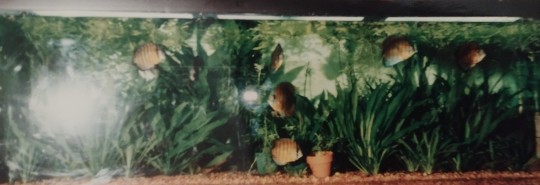
Some of the wild discus my dad had in the 90s. They were so beautiful.
396 notes
·
View notes